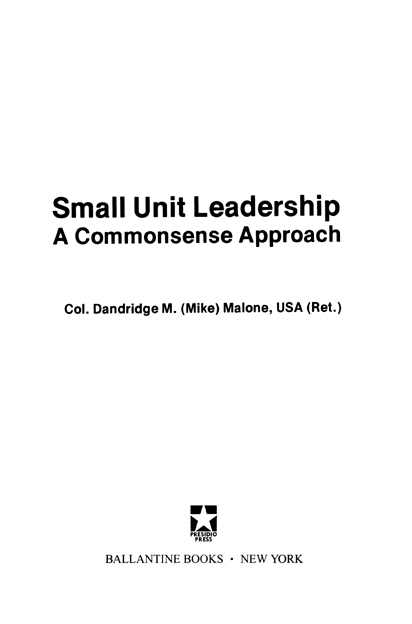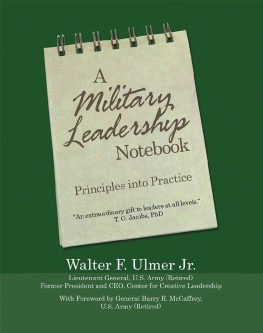Malone - Small unit leadership: a commonsense approach
Here you can read online Malone - Small unit leadership: a commonsense approach full text of the book (entire story) in english for free. Download pdf and epub, get meaning, cover and reviews about this ebook. City: New York, year: 2011;2012, publisher: Random House Publishing Group;Ballantine Books, genre: History. Description of the work, (preface) as well as reviews are available. Best literature library LitArk.com created for fans of good reading and offers a wide selection of genres:
Romance novel
Science fiction
Adventure
Detective
Science
History
Home and family
Prose
Art
Politics
Computer
Non-fiction
Religion
Business
Children
Humor
Choose a favorite category and find really read worthwhile books. Enjoy immersion in the world of imagination, feel the emotions of the characters or learn something new for yourself, make an fascinating discovery.

- Book:Small unit leadership: a commonsense approach
- Author:
- Publisher:Random House Publishing Group;Ballantine Books
- Genre:
- Year:2011;2012
- City:New York
- Rating:5 / 5
- Favourites:Add to favourites
- Your mark:
- 100
- 1
- 2
- 3
- 4
- 5
Small unit leadership: a commonsense approach: summary, description and annotation
We offer to read an annotation, description, summary or preface (depends on what the author of the book "Small unit leadership: a commonsense approach" wrote himself). If you haven't found the necessary information about the book — write in the comments, we will try to find it.
Malone: author's other books
Who wrote Small unit leadership: a commonsense approach? Find out the surname, the name of the author of the book and a list of all author's works by series.
Small unit leadership: a commonsense approach — read online for free the complete book (whole text) full work
Below is the text of the book, divided by pages. System saving the place of the last page read, allows you to conveniently read the book "Small unit leadership: a commonsense approach" online for free, without having to search again every time where you left off. Put a bookmark, and you can go to the page where you finished reading at any time.
Font size:
Interval:
Bookmark:


A Presidio Press Book
Published by The Random House Publishing Group
Copyright 1983 by Presidio Press
All rights reserved.
Published in the United States by Presidio Press, an imprint of The Random House Publishing Group, a division of Random House, Inc., and simultaneously in Canada by Random House of Canada Limited, Toronto.
Presidio Press and colophon are trademarks of Random House, Inc.
www.presidiopress.com
Library of Congress Cataloging-in-Publication Data
Malone, Dandridge M. (Dandridge Mike), 1930
Small unit leadership.
1. Command of troops. 2. Leadership. I. Title.
UB210.M23 1983 355.33041 83-4268
eISBN: 978-0-307-54671-5
v3.1_r2
On the battlefield. Thats where it is that youCaptain, Lieutenant, Sergeantwill do what it is our Army meant for you to do when you were offered the chance to become a small-unit leader.
The mission of the Armed Services is to defend this nation. Our Armys part of that mission is to fight the land battle. Your part of the Armys mission is to lead soldiers and small units during that battle. As a troop leader, thats what youre for and why you are. Your ultimate purpose is to lead. Troopers. On the battlefield.
As you study this leadership book, you will see many examples from the combat arms. But this book is not just for the combat arms. It is designed for use by all small-unit leaders in all kinds of units. How to lead doesnt change that much from one kind of unit to another. The missions may vary and the situations may vary, but the central responsibilities of leaders in a rifle company are not all that different from the leadership responsibilities of the leaders in, say, an MP company. If and when war comes, our whole Army will be on the battlefield.
As youll see in a moment, this book will describe vividly the demands of the battlefield. But most of this book will describe how to prepare for that battlefieldhow to prepare yourself, your soldiers, and your unit before the battle begins. The reason for this emphasis is pretty simple. Performance during battle is like the tip of an iceberg. It requires a whole lot of supportunder the surface, behind the scenesbefore the first round is fired. And the outcome of any battle is determined, with few exceptions, by how well soldiers and units and their leaders were prepared. Individual heroic actions can sometimes turn the tide of battle, but the real key to success on the battlefield, in any army, at any time, has always been well-trained soldiers in well-trained units. The message here should be clear. As a small-unit leader, you should only be doing one of two things:
LEADING SOLDIERS AND SMALL UNITS DURING BATTLE
PREPARING SOLDIERS AND SMALL UNITS TO FIGHT THE BATTLE
This book was written for company-level leaders, for those who wear the green tabs. For you, Captain, and for you, Lieutenant, and for you, Sergeant. It is a guide, a road map, to help you build small units that can destroy and defeat small enemy units. The challenge is immediate. We dont know where or when that next battle will be fought. But we know, from history, that the battle will come. And it could come anytime, at a number of different locations. Building battle-ready units must be your number one priority, starting now.
The objective of this first chapter is to give you the big picture of small-unit leadership. Once you get a handle on that, the later chapters will begin to lay out specific leadership techniques and tools and tricks of the trade. With some idea of the big picture, you can then see how all these techniques and tools fit together to give you what you need to lead.
There is an easy way to understand the big picture: three words. If youll listen out across this big Army of ours, and if youll listen at small-unit level, youll hear leaders using three words that were seldom heard just a few years ago: TASK, CONDITIONS, and STANDARDS.
These are not just training words. They are also leadership words. Put together the right way, they describe very clearly whats expected of you as a leader.
The whole purpose of leadership is simply to accomplish a task. That may sound too simple, but thats what a leader is expected to do. He gets a TASK in the form of a mission or order, and then he gets that task done through the efforts of his followers.
Political leaders, community leaders, and even scout leaders are all like you, to some extent. All of you try to put people and things and time and effort together to accomplish a task. The big difference is that you are an Army leader. What that means is that, in the final analysis, you must be ready someday, somewhere, to lead soldiers to accomplish an ultimate task that no one else wants to do, under conditions that no one else wants to tolerate. Small-unit leaders of the combat arms will usually lead this ultimate taskbut any of us might someday get the call, no matter what our rank or branch or MOS.
This ultimate task is what makes you as an Army leader so different from all those other leaders. Its also the essence of being a soldier. It underlies the meaning of service as well, and it is the underpinning of the whole idea of military duty. All these things mean being ready to give up freedom, and even life, for the sake of our nation and its people, in what has been called the noblest act of mankind. At bedrock level, thats what Army leadership is all about. And thats why Army leadership is so important. An awesome responsibility.
To accomplish a taskthats your purpose. You have done or will do this a thousand times, in response to orders direct, or implied, or trained into you. Orders that come down to you through the one thing that links all our leaders togetherthe chain of command. The chain of command controls, coordinates, and supports. It also challenges. Think about that time when leadership and soldier and service and duty will all come together, when the chain of command will give you that ultimate task to accomplish, when it will say to you, Attack!
The artillery shifts, and small-arms crack, and men tremble, and the platoon tenses for the final assault up the hill. You give the signal and they go. Why is it that John T. McFerren, soldier, U.S. Army, obeys your order? Leadership, or followership? Neither. Its both. Listen.
John T. McFerren assaults up into this kill-or-die situation because
a. HIS BUDDIES ARE COUNTING ON HIM TO DO HIS JOB.
b. HE THINKS HIS BUDDIES WILL CALL HIM A COWARD IF HE DOESNT ATTACK.
c. HE HAS LEARNED THAT HIS LEADER KNOWS THE RIGHT THING TO DO.
d. HE WANTS TO PLEASE HIS LEADER.
e. HE BELIEVES HE WILL BE COURT-MARTIALED IF HE DOESNT ATTACK.
f. HE THINKS HE WILL BE LEFT ALONE IF HE DOESNT ATTACK.
g. HE BELIEVES THAT FOLLOWING ORDERS IS THE RIGHT THING TO DO.
h. HE BELIEVES HE WILL BE REWARDED FOR ATTACKING.
i. HE BELIEVES THAT ATTACKING IS LESS DANGEROUS THAN NOT ATTACKING.
j. HE BELIEVES HE WILL FEEL GUILTY IF HE DOESNT ATTACK.
Font size:
Interval:
Bookmark:
Similar books «Small unit leadership: a commonsense approach»
Look at similar books to Small unit leadership: a commonsense approach. We have selected literature similar in name and meaning in the hope of providing readers with more options to find new, interesting, not yet read works.
Discussion, reviews of the book Small unit leadership: a commonsense approach and just readers' own opinions. Leave your comments, write what you think about the work, its meaning or the main characters. Specify what exactly you liked and what you didn't like, and why you think so.













